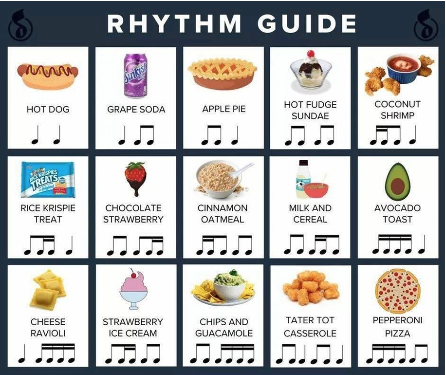
Whether you’re trying to master Twinkle, Twinkle, Little Star, or working towards one of Liszt’s
Hungarian Rhapsodies, you might have come across challenging rhythmic patterns. No matter your
instrument, understanding rhythm is a crucial skill every musician should have. Fortunately, there are
many ways to improve your knowledge.
Here are our top 10 rhythm exercises that are guaranteed to help you. Before you dive in, be sure to check our rhythm basics!
As long as you know the basics, this is a good place to start rhythm exercises. The rhythms can be played on your instrument, using a metronome for more accuracy. You can also clap them or pronounce them, using ta or any syllable you wish.
You can find these sheets in music books, but also online. In case you want to check if you are doing it
right, you can also use online rhythm randomizers. At last, we recommend writing these sheets yourself
to maximize learning.
When you feel comfortable enough with one line, you might want to explore polyrhythms. But what are
those?
They are just two lines playing simultaneously. Granted, you might not achieve great success with
polyrhythms on a flute, but you can still use your hands or your voice!
You can use the resources cited above and simply practice two lines at the same time. You can use
your left hand for the bottom line and your right hand for the top one. Alternatively, you can clap the
bottom line and use your voice for the top one. Just make sure both lines are at the same time signature
and the barlines are visually aligned.
Begin with a slow and steady pace. Walk the beats and clap subdivisions such as two eighth notes,
triplets, or four sixteenth notes. Change every four or eight steps. Once comfortable, start exploring
with dotted or syncopated rhythms.
This will sound silly and it totally is, but not all rhythm exercises need to be serious. However, you are more likely to assimilate information through things you are familiar with.
For example, two eighth notes become Bra-zil, and four sixteenth notes Gua-te-ma-la. If geography isn’t your thing, you can choose any subject you like and make it your own.
Here is something for the foodies:

If you are stuck with a rhythm or simply want to practice, this is a great exercise. You have several
options. The first is to play the music on any streaming platform and follow the sheet music. If you get
lost, start again and adjust the playback speed if needed. Be sure to have the correct arrangement of
the music.
The second option is to follow the score within music notation software. This usually requires the
music to be available within the software or using online catalogs such as Musescore.
Look at the rhythm below. You might have no idea how to play it, but you actually do. This is the
beginning of Tchaikovsky’s Swan Lake theme. Suddenly, it all makes sense!

Having references comes in handy when learning and memorizing rhythms. Think of all the different
melodies you know and have a look at what they actually look like.
This one might be tricky because it requires the involvement of another music-savvy person. However,
you can bypass this by using a pre-recorded dictation on YouTube or online. Alternatively, you can just
play any tune and try to identify the rhythm.
Dictation comes with a lot of benefits. It will help you develop the ability to recognize rhythms by
yourself while making you familiar with the rules of written notation/
You might think “But I don’t even know half of the existing rhythms!” and well, you probably aren’t
wrong (there are many). Keep your expectations low and start with a short and easy tune. Once you
figure out the melodic part, focus on the rhythm. Does it start with a half note or a whole note? Does it
sound like anything you know?
Chances are, you won’t be able to write exactly what you played, and that is okay. The goal is to get as
close as possible to the tune you played. This exercise might not be easy, but it will definitely help you
become confident with rhythms.
If you’re into rhythm games, this one is for you. Clapping Music is one of Steve Reich’s most notable
works. It consists of patterns intended to be performed entirely by clapping. The app is challenging but
teaches you how to play the piece in a fun way. It is available for iOS.
This last bit is not a rhythm exercise per se, but if you feel stuck or need feedback on your progress, getting in touch with a teacher or a fellow musician is always a good idea. You might not be aware of the
recurring mistakes you’re making and might incorporate them into your further practice.
Rhythm exercises should be an important and regular part of every musician’s practice regime. These top ten rhythm exercises will give some inspiration to incorporate into your practice.
Anja Drozdova is a Swiss-Russian musician and music teacher. She focuses on finding creative ways to engage students during piano and music theory lessons by using different mediums such as technology and visual arts. Anja also writes electronic pop music under the artist name Mlkshk. Her music is inspired by everyday life, scenes from childhood, and imaginary places, shapes, and colors.
Thanks for reading our article on the top 10 rhythm exercises for musicians of all levels! We at Soundbrenner are dedicated to helping musicians stay focused on what truly matters: their music. By creating innovative devices, such as Soundbrenner Pulse and Core, our goal is to deliver the best possible practice experience for musicians. Click here to find out more.
Got a question about Soundbrenner wearables? Reach out to us at [email protected], we’re happy to help!